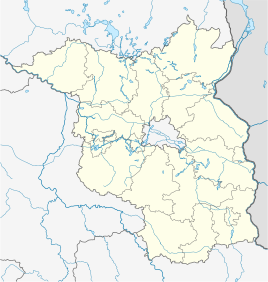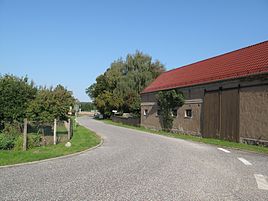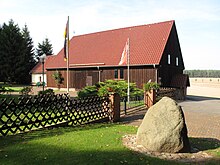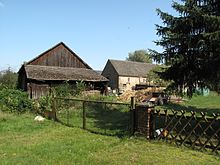Schwenow
|
Schwenow
City of Storkow (Mark)
Coordinates: 52 ° 8 '32 " N , 14 ° 2' 35" E
|
||
|---|---|---|
| Height : | 51 m | |
| Area : | 78.6 km² | |
| Residents : | 63 (Dec 31, 2006) | |
| Population density : | 1 inhabitant / km² | |
| Incorporation : | 1st January 1973 | |
| Incorporated into: | Limsdorf | |
| Postal code : | 15859 | |
| Area code : | 033678 | |
|
Location of Schwenow in Brandenburg |
||
|
Schwenower Dorfstrasse, part of Kreisstrasse 6726
|
||
Schwenow is part of the municipality in the Limsdorf district of the city of Storkow (Mark) ( Oder-Spree district , Brandenburg). On January 1, 1973 Schwenow was incorporated into Limsdorf.
geography
Schwenow is 14 kilometers as the crow flies from Storkow (Mark) and around 14 kilometers southwest of Beeskow . The district of Schwenow borders in the north on Limsdorf and Ahrensdorf , in the east on Görsdorf , in the south on Werder / Spree and Pretschen , in the south-west on Alt-Schadow and in the west on Kehrigk . Schwenow can be reached via the district road 6726 from Werder / Spree or Limsdorf. A smaller connecting road also leads to Premsdorf .
The highest points of the district are the Blocksberge with two hills of 110.5 and 110.6 m. The lowest point is a depression in the Schwenower Forest nature reserve at 42.8 m. The Schwenowsee belongs to the district . In the northeast, the Blabbergraben forms the boundary to Görsdorf for a few hundred meters. A ditch runs from north to south through the Schwenower Forest nature reserve . The Schwenowseegraben flows from the northeast into the Schwenowsee and leaves it at the southeast end to the Drobschsee , thus flowing into the Blabbergraben. Over 90% of the district is occupied by the forest.
history
The place was first mentioned in 1490 and thus late as Swehn . In 1496 it is called Schweyn and in 1517 it is called Schwynaw and Schweynaw . In 1534 the spelling changed to Schweno and finally in 1584 to Schwenow . The name book holds the origin of the place name from an aso. Basic form * Svin'e = place where wild boars occur, for most likely. Another interpretation would be the derivation of a basic form * Zvenov- to a root ursl. * zven-, in Lower Sorbian * zněś = tones, sounds, loud, echoes, sounds. Eichler is considering a connection with * nso. * zwenjo = ring, wheel rim. The village structure is described as a lane village with a good. However, the estate did not emerge until the 1630s. Originally Schwenow did not have a knight's seat.
Ownership history
At the time of the first mention, the place belonged to the house of the Biebersteiner , the owners of the Beeskow and Storkow domains at that time . In 1518, the Biebersteiner had the services of four farmers in Schwenow and their duties to the family v. Rathstock awarded. Apparently this loan piece came back to the rule or the office of Beeskow . In 1584 the village was exchanged for individual properties owned by those von Oppen in Diensdorf , Glienicke , Ranzig and Buckow . On July 20, 1584 Georg von Oppen received from Elector Johann Georg the enfeoffment with the Schulzengericht Schwenow and eight Hufen in the place in exchange for the Schulzengericht Glienicke. It then belonged to Gut Kossenblatt until the 1630s. When the estate Kossenblatt was divided, Georg (the younger) von Oppen, son of Georg (the elder) von Oppen and Anna von Klitzing received Schwenow.

From around 1633 he built his own knight's seat in Schwenow. In 1644 he bought the village of Groß Köris from Joachim-Friedrich Schenk von Landsberg auf Buchholz in what was then Teupitz . In 1647 he acquired half of Krausnick and Köthen and a quarter of the village of Leibsch from the brothers Antonius, Otto and Heinrich Ernst von Langen zu Wasserburg, and in 1648 he received the loan. Georg the Younger von Oppen was married to Anna Sibylle von Langen from the (Groß) Wasserburg house. With her he had the sons Georg (III.), Christoph and Erdmann. In his second marriage he was married to Sabina von Maltitz, with whom he had nine other sons: Jobst, Caspar, David, Hans Georg, Gustav, Albrecht, Johann Niclaus, Joachim and Christoph. Georg the Younger died in Schwenow in 1651. The son Erdmann was married to Catharina Sabina von Maltitz; The sons George Nicol, Caspar Friedrich, Hans Christoph and Erdmann sprang from the marriage. Caspar was married to Barbara Sabina von Oppen from the Kossenblatt family. The sons Hans Friedrich, Caspar Christoph and Hans Heinrich auf Schwenow emerged from this marriage. In 1662 David married Anna Elisabeth von Maltitz, daughter of Hans Ernst von Maltitz von Tauche. The village remained in the possession of the von Oppen family until 1738.
On May 27, 1738, Friedrich Wilhelm I bought the village of Schwenow from Georg Henning von Oppen for 14,100 thalers in addition to the Kossenblatt office . The Kossenblatt office was one of the 14 offices of the royal Prussian rule of King Wusterhausen . The Vorwerk in Schwenow was leased to bailiff Reinicke in 1798. In 1801 it came to bailiff Carl Sternitzky zu Siethen , whose heirs also received the Schwenow and Drobschsee lakes in leasehold. In 1814 Sternitzky died. His grave is on a hill inclined towards Lake Schwenower in a grove of locust trees near Schwenow. The stone cross bears the inscription: "Here rests in God with his wife Carl Sternitzky, died April 28th, 1814". In 1815 Johann Christian Gottlieb Paschke (1783–1842) leased the Vorwerk in Schwenow, which is also documented for 1837. In 1814 he had Wilhelmine Sophie v. Sternitzky, daughter of Friedrich Ferdinand Franz Sternitzky married. In 1853 the royal house fide commission office in Trebatsch bought back the Schwenow works for 25,000 thalers from Ludwig Carl Friedrich Traun. In 1853 it was 1,534 acres , of which two acres were on the courtyard, 16 acres in the garden, 879 acres were fields, 193 acres of meadows, 252 acres of forest parcels, 158 acres of lake and 34 acres of paths and ditches (Berghaus, on the other hand, has a size of 1328 a.m.).
Oberforsterei Schwenow
From the Vorwerk Schwenow, the Oberförsterei Schwenow was built between 1853 and 1855. In 1853 August Messow was the first royal chief forester in Schwenow.
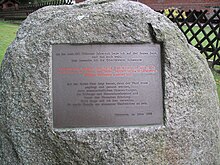
At the same time, the Schwenow forest district was formed by merging the Kossenblatt forest district with parts of the newly acquired, previously fiscal forest district of Alt-Schadow. The chief foresters' offices in Kossenblatt and Alt-Schadow were dissolved. The Vorwerk area was partly managed as the chief forester's service land. The earlier wooded parcel was assigned to the forest district. Other plots were leased, and areas previously used as arable land were also reforested. The forest ranger was housed in the buildings of the former sheep farm. The Werder / Spree protection area, which was supervised by the forest ranger in Schwenow, the protection area and the forester's house in Sabrodt, the protection area and forester's house Tschinka , the protection area and forester's house in Neu Lübbenau, the protection area and forester's house Grubenmühle and the protection area and forester's house Neue Mühle were assigned to the Oberförsterei Schwenow .
The forest district formed its own manor district. The head forester's office was under the Royal Prussian Court Chamber Administration until 1921. It was not taken over by the Prussian state until 1921. She stayed on during the GDR times as chief forester. In 1977 it also had a branch in Groß Eichholz (travel wood yard). In 1990 it was taken over by the state of Brandenburg. In addition to the sovereign tasks, it is responsible for the management of over 5000 hectares of forest in state ownership, from which around 15,000 cubic meters of wood are felled every year. She is also responsible for the maintenance and regeneration of the forest and nature conservation. The specialty of the Oberförsterei Schwenow are the teaching and testing areas of the state of Brandenburg. Various research projects are carried out here, e.g. Partly carried out in international cooperation with the Eberswalde State Forestry Agency.
Village history
In 1518 the Lehnschulze cultivated three hooves, three farmers two hooves each, one of the three farmers also had a wild hoof in his cultivation, two farmers with one hoof each. There was also a kossat in the village. Four peasants earn one from Rathstock. In 1537, in addition to Lehnschulze, the five farmers, three Kossäts lived in Schwenow. For 1556 one Schulze, seven Hüfner and 12 Kossäts are mentioned; the latter number is doubtful, however. In 1576 the numbers are: eleven farmers, two cottagers and one housekeeper. For 1584 the social structure is given with a Lehnschulzen, eight Hüfner and two Kossaten. In 1600 the Feldmark had 22 farmer's hooves; a shepherd is also named for this year. In the Thirty Years War the place was destroyed and largely depopulated. In 1652, out of nine designated farm sites, just two farm sites (each with two hooves) were cultivated. The Lehnschulzengut with three hooves and another three hoof farm were not occupied. Three two-hoofed farms were in a desolate position, one farm was run by a househusband, another farm by a kossat. A total of 20 hooves were identified on the field mark. Of the four other cottages, three were single . The shepherd lived in the community shepherd's house. A manor had been formed from the wild hooves; the farm run by a househusband and the farm run by a kossaet had also been moved to the manor.
In 1692 the number of farm positions is given as eleven, of which only two two-hoofed farms were occupied by farmers. There were also two cottagers and a shepherd living in the village. In the three fields, the third grain was not harvested every year. The farmers could harvest four loads of hay each on their meadows, and two loaders of hay on their meadows. There was only mediocre guarding; the locals kept sheep. But they had no fishing rights and only poor logging. In 1724 the size of the field marrow is given as 24 hooves. In 1745 there was a sheep farm next to the farm. It was a little set off to the west of the town center. Wine was grown on a vineyard east of the village. In 1840 the field name Weinberg is still recorded. Two farming families and four farm families lived in the village. In 1775 the last farmers had also disappeared, and there were only 13 Büdner (or others) left. The indication 13 "fire places" should be understood as 13 houses. In 1801 there was the hereditary interest of the Kossenblatt office, the sheep farm and, for the first time mentioned, also a jug in the village. 16 residents with their families were resident in Schwenow, a total of 91 residents. The number of fireplaces had grown to 14. In 1827 the Beeskow office leased the Krug-Verlag, d. H. the right to deliver to the upper and lower taverns as well as the Mühlenschänke in Kossenblatt, the Kruges in Briescht, the taverns in Schwenow and Giesensdorf and the taverns in Werder / Spree for six years. In 1837 there were already 21 houses in which 132 people lived.
In 1858 there were 19 residential buildings and 25 farm buildings in the village. A public building and four farm buildings belonged to the chief forester's office. A public and two farm buildings belonged to the forest ranger's house. In 1864 the social structure of the village is given as 10 Büdners and three colonists. In 1900 there were 17 houses in the village, and seven buildings belonged to the chief forester's office. In 1929 the manor district of Forst Schwenow was dissolved and incorporated into the communities of Alt-Schadow, Briescht, Glienicke, Kossenblatt, Limsdorf, Sabrodt, Schwenow, Trebatsch, Wendisch Rietz and Weder / Spree. The rest was merged with parts of the Kleinwasserburg manor district, also in 1929. The rural community Schwenow had 86 inhabitants in the village in 1933 and the residential areas Forsthaus Schwenow and Oberförstereigehöft Schwenow. In 1939 there was an agricultural and forestry operation of over 100 hectares, one operation with 20 to 100 hectares, six operations with 10 to 20 hectares, six operations with 5 to 10 hectares and seven operations with 0.5 to 5 hectares. In the land reform there were no expropriations, the forest was taken over by the state. In 1960 an agricultural production cooperative (LPG) type I was formed with 12 companies, 15 members and 77 hectares of usable area. It was merged with LPG Type III Limsdorf in 1972.
| Population development from 1774 to 1971 | |||||||||||||||||
|---|---|---|---|---|---|---|---|---|---|---|---|---|---|---|---|---|---|
| year | 1774 | 1801 | 1818 | 1837 | 1858 | 1875 | 1890 | 1910 | 1925 | 1939 | 1946 | 1950 | 1964 | 1971 | |||
| Residents | 61 | 91 | 102 | 132 | 124 | 115 | 109 | 105 | 105 | 97 | 106 | 117 | 125 | 108 | |||
Political and community affiliation
In the late Middle Ages Bornow still belonged to the Beeskow rule , which at that time was still part of Niederlausitz . In 1518 Ulrich v. Bieberstein the rule of Beeskow came to the Bishop of Lebus . In 1556 the pledge was passed on to the Brandenburg (co-) elector Johann von Küstrin . Elector Johann von Küstrin died in 1571, and in 1575/6 the rule of Beeskow (and also the rule of Storkow ) came de facto to Brandenburg, but remained de jure a fiefdom of the Bohemian crown until 1742. The Beeskow rule left Niederlausitz in 1576. In the 17th and 18th centuries, the Beeskow-Storkowische Kreis was formed from the two lords of Beeskow and Storkow . In 1815 this circle was dissolved. The area of the former rule Beeskow was connected to the district of Lübben , the area of the former rule Storkow was combined with the Teltowic district to form the Teltow-Storkow district . In 1835 the division of the two dominions was reversed and the Beeskow-Storkow district was created . In a first district reform in 1950 in what was then the GDR, the Beeskow-Storkow district was dissolved again and largely assigned to the Lübben district, the northern part - including Bornow - came to the Fürstenwalde district . In 1952, this division was largely reversed and the new Beeskow district in the Frankfurt (Oder) district was formed. On January 1, 1973 Schwenow was incorporated into the neighboring municipality of Limsdorf and has since been part of Limsdorf.
After the fall of the Berlin Wall, the Beeskow district was renamed the Beeskow district . In 1992 Limsdorf joined with 13 other municipalities to form the Storkow (Mark) office with its seat in the city of Storkow (Mark). On December 6, 1993, the district of Beeskow was finally merged with the districts of Fürstenwalde , the independent city of Eisenhüttenstadt and the district of Eisenhüttenstadt to form the Oder-Spree district .
On March 31, 2002, the communities Alt Stahnsdorf, Limsdorf, Schwerin, Wochowsee and the city of Storkow formed the "new" city of Storkow (Mark). The remaining municipalities of the Storkow (Mark) office were incorporated into the city of Storkow (Mark) on October 26, 2003 through the Sixth Law on State-wide Municipal Area Reform. The Storkow (Mark) office was dissolved. The former municipalities, including Limsdorf, are now districts of the city of Storkow (Mark). Since then, Schwenow is only a part of the municipality of Limsdorf without its own local representative or mayor.
Church affiliation
Schwenow does not have its own church, but was always parish to Kossenblatt. Briescht, Werder / Spree, Wulfersdorf and Giesensdorf were also parishes after Kossenblatt.
natural reserve
The Schwenower Forest nature reserve includes parts of the forest with the valley of the north-south trench and its valleys. However, it continues to include the Blabbergraben on the districts of Görsdorf, Werder / Spree and Kossenblatt. It also includes the Tiefen See or Grubensee in the Limsdorf district.
Monuments and sights
The list of monuments of the state of Brandenburg for the Oder-Spree district lists the following archaeological monuments:
- No.90826 Hall 3: a Bronze Age settlement, a Stone Age settlement
- 90827 Corridors 1 and 2: a settlement from prehistory, a resting and working place from the Mesolithic
- Nr.90828 Corridor 3: the village center of the German Middle Ages, the village center of the modern age, a settlement of the Slavic Middle Ages, a settlement of prehistory
- 90888 Hall 3: a settlement from prehistory
- Nr.90660 Schwenow Flur 3 / Werder Flur 2: a settlement from prehistory, a settlement from the Stone Age
supporting documents
literature
- Heinrich Karl Wilhelm Berghaus: Land book of the Mark Brandenburg and the Markgrafthum Nieder-Lausitz in the middle of the 19th century; or geographical-historical-statistical description of the Province of Brandenburg, at the instigation of the State Minister and Upper President Flottwell. Second volume. 650 p., Printed and published by Adolph Müller, Brandenburg 1855 (in the following abbreviated, Berghaus, Landbuch, 2 with corresponding page number)
- Joachim Schölzel: Historical local dictionary for Brandenburg. Part IX Beeskow-Storkow. 334 p., Hermann Böhlaus successor, Weimar 1989 ISBN 3-7400-0104-6 (hereinafter Schölzel, Historisches Ortslexikon, Beeskow-Storkow, page number).
- Francesko Rocca: History and administration of the royal family property: according to the files and documents of the Kgl. Court Chamber in Charlottenburg compiled. 522 p., Berlin, Rohde, 1913–1914 (hereinafter abbreviated to Rocca, Königliche Familiengüter with corresponding page number)
- Heinrich Karl Wilhelm Berghaus: Land book of the Mark Brandenburg and the Markgrafthum Nieder-Lausitz in the middle of the 19th century; or geographical-historical-statistical description of the Province of Brandenburg, at the instigation of the State Minister and Upper President Flottwell. Second volume. 650 p., Printed and published by Adolph Müller, Brandenburg 1855 (hereinafter abbreviated to Berghaus, Landbuch, 2 with corresponding page number).
Individual evidence
- ↑ Community and district directory. In: geobasis-bb.de. Land surveying and geographic base information Brandenburg, accessed on 23 September 2018 .
- ↑ Main statute of the city of Beeskow from April 22, 2009 PDF (39 KByte)
- ↑ a b contribution to statistics. State Office for Data Processing State of Brandenburg Statistics. Historical municipality register of the state of Brandenburg 1875 to 2005 19.9 District Oder-Spree PDF
- ^ Sophie Wauer (after preliminary work by Klaus Müller): Brandenburgisches Namenbuch Part 12 The place names of the Beeskow-Storkow district. 269 pp., Franz Steiner Verlag, Stuttgart 2005, ISBN 3-515-08664-1 , p. 49
- ↑ a b Schölzel, Historisches Ortslexikon Beeskow Storkow, S.36 / 7.
- ↑ Friedrich Beck: Document inventory of the Brandenburg State Main Archive - Kurmark, 2: Municipal institutions and noble lords and goods. VII, 820 pp., Berlin, Berlin-Verl. Spitz 2002 ISBN 3830502923 (also publications of the Brandenburg State Main Archive Potsdam 45), p. 546.
- ↑ Friedrich Beck: Document inventory of the Brandenburg State Main Archive - Kurmark, 2: Municipal institutions and noble lords and goods. VII, 820 pp., Berlin, Berlin-Verl. Spitz 2002 ISBN 3830502923 (also publications of the Brandenburg State Main Archive Potsdam 45), p.668 / 9.
- ↑ Johann Christoph Eilers: Chronicon Beltizense or Beltziger Chronik, which includes the antiquity of the city and countryside Beltzig, u. the beginning of the Christl. Religion here still expelled the Wends. 644 pp., Wittenberg, Eichsfelder, 1743 Online at Google Books (p.477 / 8)
- ↑ Edward; Lamprecht, Karl Heydenreich: Handbook of practical genealogy. Vol. 2. 2., very probably and reworked. Ed., 483 pp., Leipzig, Degener 1913 Online at archive.org (p.178)
- ↑ Rocca, Royal Family Estates, p. 6.
- ↑ Rocca, Royal Family Estates, p. 13.
- ↑ Official Gazette of the Royal Kurmark Government in Potsdam, 1815, extra sheet to the 28th issue of the Official Journal of the Royal Kurmark Government, from July 21, 1815 without pagination (p.6) online at Google Books
- ↑ a b August von Sellentin: Topographical-statistical overview of the government district of Potsdam and the city of Berlin. 292 p., Berlin, Verlag der Sanderschen Buchhandlung, 1841 (p. 267)
- ↑ Rocca, Royal Family Estates, p. 10.
- ↑ a b Berghaus, Landbuch, 2, p.599 []
- ^ Lothar Welke: Oberförsterei Schwenow. Online publication. PDF
- ^ Official Journal of the Royal Prussian Government of Potsdam and the City of Berlin, year 1827, Oeffentlicher Anzeiger as a supplement to the 16th issue of the Official Journal of April 18, 1827 Online at Google Books (p.112)
- ^ Rudolf Lehmann: Studies on the history of the church organization and administration of the Lausitz in the Middle Ages. 246 p., Colloquium-Verlag, Berlin 1974, ISBN 3-7678-0339-9 (= individual publications of the Historical Commission in Berlin, Volume 13), also: St-Benno-Verlag, Leipzig 1986, ISBN 3-7462-0127- 6 (= studies on the history of the Catholic diocese and monastery, volume 28) (p.22)
- ↑ List of monuments of the state of Brandenburg: Landkreis Oder-Spree (PDF) Brandenburg State Office for Monument Preservation and State Archaeological Museum
